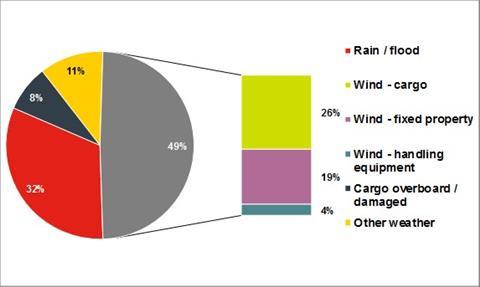The freight insurer’s analysis of weather claims showed ships were better secured in ports, but containers and equipment were still being blown away, creating more claims
TT Club has published an analysis of supply chain risks relating to extreme weather, showing damage has increased over the past decade and is becoming more unpredictable.
North Atlantic hurricanes and western Pacific typhoons remain leading sources of severe weather claims, but European storm claims and damage costs have gone up, TT Club reported.
The marine freight insurer, which focuses on port installations, looked at worldwide claims trends between 2007 and 2016.
“Perhaps unsurprisingly with recent media coverage of the significant damage occurring across the Caribbean and into the US mainland, TT Club’s analysis of weather claims demonstrates the preponderance of claims arising from storm surge and flooding,” the insurer said.
“However, the totality of costs resulting directly from wind is notable,” TT Club added.
Heavy rain and flooding (32% of claims) associated with storms are often difficult to prevent when cyclonic swells, tides or flooded river deltas surge into the port and terminal areas, noted TT Club.
“Rising sea levels and the increasing potential for storm surge in littoral locations in any part of the globe mean that planners and engineers need take particular care in the design and location of future port developments,” continued the insurer.
The insurer highlighted that many of the claims were avoidable or could have been reduced.
“For example, during the last decade, the number and cost of incidents of quay cranes being blown along the berth has decreased substantially, due in some part to publicity campaigns to raise awareness of the issue and loss prevention actions,” said TT Club.
“However, the impact of wind on smaller items of handling equipment, containers and breakbulk cargo resulted in a total of 30% of the claims cost incurred. Again, recent images clearly show how easily empty containers can be displaced from their stacks during storm conditions,” continued the insurance firm.
Risks to ships in port were being better managed over the past decade, according to TT Club, including impact to the berth or cranes from large swells or high winds, suggesting improvements in ship movement and berthing procedures.
“Such procedures include parking quay cranes away from the bridge or stern of the ship when berthing or in the centre of where the ship will berth, ensuring the quay crane boom is raised during the process,” said TT Club.
“Furthermore, it would appear that many ports have implemented improved pilotage procedures and considered in detail the use and size of tugs. Naturally, procedures in extreme weather conditions need to be reviewed and – as with any emergency process – practised periodically.”
TT Club, partnering with ICHCA International, has produced a handbook on weather risk for port facilities, “Windstorm II: Practical risk management guidance for marine and inland terminals”.
Chart below: Cost of weather related claims by cause type. Source: TT Club.





















No comments yet